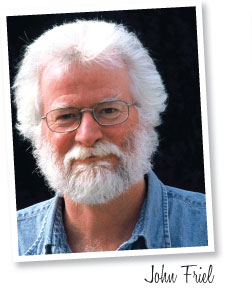2/1/2019
Wet Enough For Ya?
John Friel

If a tree falls into a river and you’re not there to hear it, does it make a noise?
I made plenty of noises this year, not all suitable for a polite publication. My chainsaw made plenty more.
Early in my hort career, before I realized I’d embarked on one, I was lamenting the state of the 1980s economy to an old-timer. He shrugged. “The economy means almost nothing in this business,” he said. “Everything depends on weather.”
If there’s an older adage than that one, it’s probably “Hard times are good times for growers. That’s when people stay home and plant gardens.” And if you grew up in the green industries, you probably heard those phrases about the same time you were being admonished, “Elbows off the table.” I didn’t, so they were news to me as an adult. Part of my initiation.
Another datum that shouldn’t surprise me, but does: In a normal year, total rainfall here in Lancaster, Pennsylvania, is roughly equal to Seattle’s. After all, nobody argued with Dave Barry when he said Washington’s nickname should be changed from The Evergreen State to The Incessant Nagging Drizzle State.
Recently departed and utterly unmourned, our 2018 was not a normal year. Had the Times Square New Year’s ball dropped here instead, it would’ve splashed down like an Apollo capsule. We ended nearly two feet above typical annual precip, far wetter than the Space Needle’s famously moist home.
How wet were we? This wet: I lost a big, seemingly-healthy hickory tree. My backyard, a.k.a. the right bank of the Conestoga River, was underwater seven times last summer and fall, by anywhere from a few inches to several feet. The soil was simply so sodden for so long that by late August it could no longer support 40 feet of trunk and limbs.
Trees are lazy. Given enough nutrients and water nearby, they won’t bother exploring farther. Spoiled by fertile soil just a few feet above normal river level, my hickory never rooted wide or deep enough to withstand week after week of weakening clay. During the nastiest flood, while I was in Oregon for the FarWest Show, breathing the smoke of endless wildfires, down it went, jutting out over the river, heaving up a surprisingly small rootball that twisted my stairs like a DNA helix.
Did you know green hickory is too dense to float? Every chunk of trunk had to be laboriously towed to shore, underwater. Four men strained to wrangle three-foot pieces onto land. It's all good firewood now, split, stacked and seasoning for next winter. But I’d rather have the tree back, damn the BTUs.
Our rainiest day, week after week, was Saturday. Sundays were hardly better. Precious key retail weekends in April, May and June were a washout. If 2018 is the new Mid-Atlantic normal, we’ll feel it. Even hard-core gardeners throw in the trowel eventually when planting becomes a wretched, muddy slog.
When you read this, I’ll have been to MANTS in Baltimore, where I’ll have heard horror stories that render mine tame. My one-tree loss merits a sarcastic Boo-hoo-you! from West Coast denizens who lost whole forests and towns. Weather is one massive distribution problem. If we could have swapped our surplus rainfall for a sampler tray of your drought, we’d all be better off. Move our soggiest days to midweek and everything changes. Unfortunately, such trades are not ours to make. We get what we get.
East is east and west is west, and ne’er the twain shall meet. What we have in common is the need to replace trees. GP
John Friel is marketing manager for Emerald Coast Growers and a freelance writer.